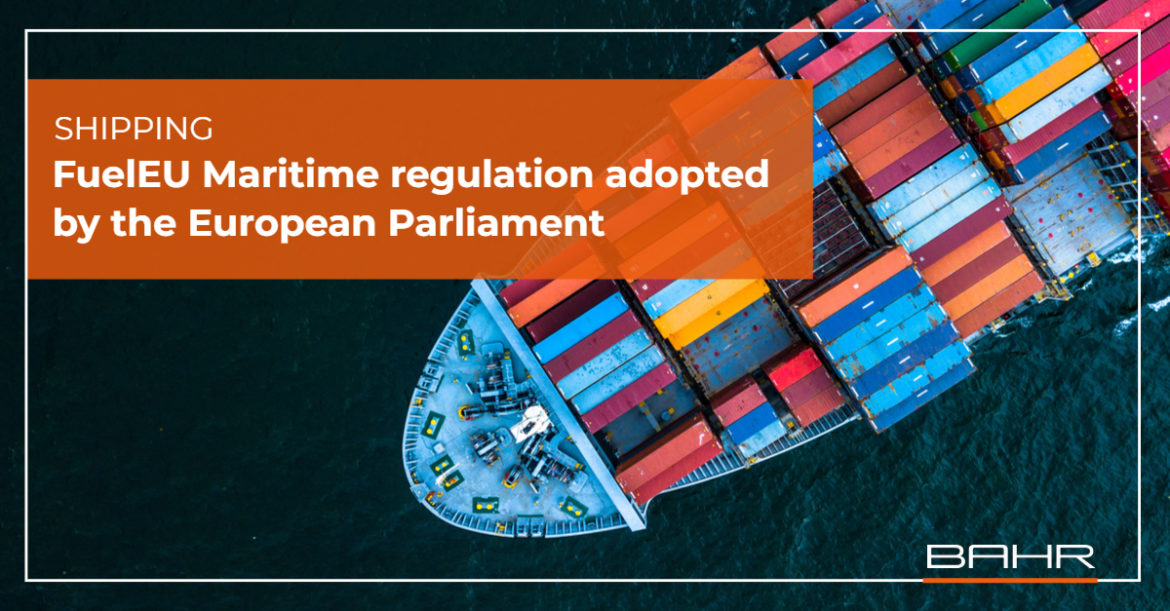Shipping | FuelEU Maritime regulation adopted by the European Parliament
The FuelEU Maritime regulation is part of the “Fit for 55 Package” – the legislative proposals to reach the emission targets of reducing greenhouse gas emissions in 2030 to at least 55 % compared to 1990 levels.
The regulation is intended to stimulate the uptake of sustainable maritime fuels and zero-emission technologies.

Background
The EU has set an ambition to be climate-neutral by 2050 – an economy with net-zero greenhouse gas emissions. This objective is at the heart of the “European Green Deal” and in line with the EU’s commitment to global climate action under the Paris Agreement. The European Green Deal was presented by the European Commission December 2019.
As part of the European Green Deal, the European Commission has set a target of greenhouse gas emissions in 2030 to 55% compared to 1990. The European Climate Law sets out in binding legislation the EU’s commitment to climate neutrality and the intermediate target of reducing net greenhouse gas emissions by 2030.
In order to reach such target – the European Commission has considered actions required across all sectors – which has led to several legislative proposals – including FuelEU Maritime.
Regulation
The FuelEU Maritime regulation (i) sets a maximum limit on the greenhouse gas intensity of energy used on-board by a vessel arriving at, staying within or departing from ports in the EU and (ii) contains certain obligations to use on-shore power supply or zero-emission technology in ports in the EU.
Maximum limit on the greenhouse gas intensity of energy used onboard by a vessel
The maximum limit on the greenhouse gas intensity of energy used onboard by a vessel will apply to all vessels above a gross tonnage of 5000 that serve the purpose of transporting passengers or cargo for commercial purposes, regardless of their flag.
The targets shall be determined against a reference value reflecting the fleet average greenhouse gas intensity of energy used onboard by vessels in 2020 and reduced by the following percentages:
- 2% by 2025
- 6% by 2030
- 14.5% by 2035
- 31% by 2040
- 62% by 2045
- 80% by 2050
The regulation applies to (i) 50% of the energy used by a vessel performing voyages arriving at a port in EU from a port outside of EU or EU outermost regions, (ii) 50% of the energy used by a vessel performing voyages departing from a port in EU and arriving at a port outside the EU or EU outermost regions, (iii) 100% of the energy used by a vessel performing voyages between EU ports, and (iv) 100% of the energy used at berth in a port in EU.
The regulation shall be reviewed by the European Commission by 2028 to decide i.a. whether to extend emission-cutting requirements to other vessel types and/or smaller vessels or to increase the share of the energy used by vessels coming from non-EU countries.
Obligation to connect to onshore power supply or zero-emission technology in ports in the EU
Passenger and container vessels are as a main rule required to connect to onshore power supply from 2030 unless they can demonstrate the use of another zero-emission technology. This will apply to Trans-European Transport Network (TEN-T) ports from 2030, and other EU ports from 2035 (or earlier of decided by the relevant member state) if these ports have on-shore power supply.
The FuelEU regulation is combined with the Alternative Fuels Infrastructure Regulation and the Trans-European Transport Network (TEN-T) to align the regulation with the development of the infrastructure for alternative fuels in the EU. This includes ensuring that the requirements to the vessels are supported by adequate recharging and refueling infrastructure.
Renewable and low-carbon fuels in maritime transport
The regulations gives incentive, in the form of offsetting emissions to those vessel owners who use renewable fuels of non-biological origin (RFNBO), from 2025 to 2034.
***
Do not hesitate to contact any of BAHR’s shipping team members for further information.
